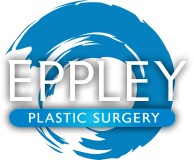Your Questions
Your Questions
Q: Dr. Eppley, I am interested in ear reconstruction. I lost my right ear several years ago in a car accident. I have attached a couple of pictures so you can see the extent of the ear loss. How can my ear be fixed?
 A: A complete ear avulsion represents the most complex type of ear reconstruction. The obvious injury seen in the pictures you sent is a traumatic avulsion of the complete external ear. In dealing with such ear injuries, there are two methods of reconstruction which are dramatically different. The first method is known as the autologous or natural tissue reconstruction method using the patient’s own tissues. The framework of an ear can be fabricated from one’s own cartilage since the ear (minus the earlobe) is cartilage covered by skin. To create the necessary skin, an initial tissue expander must be placed to stretch out (expand) the skin around the ear hole. (external auditory meatus) Once enough skin is created, the tissue expander can be replaced with an ear framework fabricated and carved out of rib cartilage. Somke minor touchups are needed later to make the earlobe and a crease or sulcus on the back of the ear. The other approach is to make a prosthetic ear which is held into placed by end osseous (dental) implants. Three implants are initially placed around the ear hole and allowed to heal. They are eventually uncovered and then used as magnetic retention posts onto which a prosthetic ear can be attached.
A: A complete ear avulsion represents the most complex type of ear reconstruction. The obvious injury seen in the pictures you sent is a traumatic avulsion of the complete external ear. In dealing with such ear injuries, there are two methods of reconstruction which are dramatically different. The first method is known as the autologous or natural tissue reconstruction method using the patient’s own tissues. The framework of an ear can be fabricated from one’s own cartilage since the ear (minus the earlobe) is cartilage covered by skin. To create the necessary skin, an initial tissue expander must be placed to stretch out (expand) the skin around the ear hole. (external auditory meatus) Once enough skin is created, the tissue expander can be replaced with an ear framework fabricated and carved out of rib cartilage. Somke minor touchups are needed later to make the earlobe and a crease or sulcus on the back of the ear. The other approach is to make a prosthetic ear which is held into placed by end osseous (dental) implants. Three implants are initially placed around the ear hole and allowed to heal. They are eventually uncovered and then used as magnetic retention posts onto which a prosthetic ear can be attached.
There are advantages and disadvantages with either approach. (autologous = multiple reconstructive surgeries, prosthetic = need to continuously remake new ear prostheses)
Dr. Barry Eppley
Indianapolis, Indiana
Q: Dr. Eppley, I have some queries about Medpor implant surgery. One of my one friends, who is age 26, is looking for ear reshaping surgery. I have a concern about him, I am suggesting him to go for own body material surgery not with medpor implant surgery. Can you give us some guideline on this. Like as which one will be the best for his future.
A: While it is not clear from your inquiry as to the nature of your friend’s ear deformity, I will assume that it is either a subtotal or total ear reconstruction. (variations of congenital microtia or traumatic amputation) That would be the only consideration in which either a synthetic implant, like Medpor, or the use of a rib graft would be debated. There are arguments for the use of Medpor vs. rib grafts and I have done both successfully. (although many more rib grafts than medpor implants) I would agree that the use of rib cartilages are far safer and have much less risk of any long-term complications, in fact there would be few if any long-term issues with a natural material. But if one uses a Medpor implant in the ear it is absolutely critical that a temporalis fascial rotation flap is used to cover the implant to put more of a vascularized cover over most of the implant. This will substantially reduce the long-term risk of skin breakdown and implant exposure.
The reality is that while many patients and some surgeons think that using a synthetic implant is ‘easier’ than harvesting and carving rib grafts for ear reconstruction, it is not just as simple as pulling a preformed ear out of a box and sticking it under the skin. The success of synthetic ear reconstructions depends on the quality of the overlying ear skin and the surrounding tissues and getting good vascularized cover which means rotating a fascial flap. Successful long-term results from ear reconstruction, whether it is done by autologous or synthetic materials, requires experienced presurgical judgment and technical experience in performing them.
Dr. Barry Eppley
Indianapolis,Indiana

